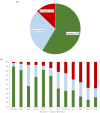Risk of Presenting with Poor-Prognosis Metastatic Cancer in Adolescents and Young Adults: A Population-Based Study
- PMID: 36230854
- PMCID: PMC9562204
- DOI: 10.3390/cancers14194932
Risk of Presenting with Poor-Prognosis Metastatic Cancer in Adolescents and Young Adults: A Population-Based Study
Abstract
Having metastatic disease at diagnosis poses the great risk of death among AYAs with cancer from all sociodemographic subgroups. This “landscape” study utilized United States Surveillance, Epidemiology, and End Results Program data from 2000−2016 to identify subgroups of AYAs at highest risk for presenting with metastases across twelve cancer sites having a poor-prognosis (5-year survival <50% with metastases). Adjusted odds ratios for risk of metastatic disease presentation were compared for AYAs in aggregate and by sociodemographic subgroup (race/ethnicity, sex, socioeconomic status [SES]). In general, AYAs who were male, racial/ethnic minorities, or low SES were at consistently greatest risk of metastases. Strikingly, having metastatic melanoma was independently associated with multiple AYA sociodemographic subgroups, including males (aOR 3.11 [95% CI 2.64−3.66]), non-Hispanic Blacks (4.04 [2.32−7.04]), Asian Pacific Islanders (2.99 [1.75−5.12]), Hispanics (2.37 [1.85−3.04]), and low SES (2.30 [1.89−2.80]). Non-Hispanic Blacks were more likely to present with metastatic cancer in all sites, except for bone, rhabdomyosarcoma, and stomach. Low SES AYAs are more likely to present with metastatic melanoma, bone tumors, soft tissue sarcomas, breast, cervical, lung, and stomach carcinomas. Building on these results, future cancer-specific studies should investigate the connection between sociodemographic risk factors and biological drivers of metastases. This line of research has potential to inform targeted public health and screening efforts to facilitate risk reduction and earlier detection of these deadly diseases.
Keywords: AYAs; Adolescents; incidence; metastatic cancer; metastatic disease; race/ethnicity; sex; socioeconomic status; young adults.
Conflict of interest statement
The authors declare no conflict of interest. The funders had no role in the design of the study; in the collection, analyses, or interpretation of data; in the writing of the manuscript, or in the decision to publish the results.
Figures






Similar articles
-
Poor-Prognosis Metastatic Cancers in Adolescents and Young Adults: Incidence Patterns, Trends, and Disparities.JNCI Cancer Spectr. 2021 Apr 27;5(3):pkab039. doi: 10.1093/jncics/pkab039. eCollection 2021 Jun. JNCI Cancer Spectr. 2021. PMID: 34250441 Free PMC article.
-
Survival of Adolescents and Young Adults with Prevalent Poor-Prognosis Metastatic Cancers: A Population-Based Study of Contemporary Patterns and Their Implications.Cancer Epidemiol Biomarkers Prev. 2022 Apr 1;31(4):900-908. doi: 10.1158/1055-9965.EPI-21-0913. Cancer Epidemiol Biomarkers Prev. 2022. PMID: 35086824 Free PMC article.
-
Emerging Cancer Survival Trends, Disparities, and Priorities in Adolescents and Young Adults: A California Cancer Registry-Based Study.JNCI Cancer Spectr. 2019 Jun;3(2):pkz031. doi: 10.1093/jncics/pkz031. Epub 2019 Jun 12. JNCI Cancer Spectr. 2019. PMID: 31276099 Free PMC article.
-
A Population-Based Observational Study of First-Course Treatment and Survival for Adolescent and Young Adult Females with Breast Cancer.J Adolesc Young Adult Oncol. 2013 Sep;2(3):95-103. doi: 10.1089/jayao.2013.0004. J Adolesc Young Adult Oncol. 2013. PMID: 24066271 Free PMC article.
-
Disparities in Adolescent and Young Adult Survival After Testicular Cancer Vary by Histologic Subtype: A Population-Based Study in California 1988-2010.J Adolesc Young Adult Oncol. 2016 Mar;5(1):31-40. doi: 10.1089/jayao.2015.0041. Epub 2015 Nov 18. J Adolesc Young Adult Oncol. 2016. PMID: 26812451 Free PMC article.
Cited by
-
Rethinking the rise of early-onset gastrointestinal cancers: a call to action.JNCI Cancer Spectr. 2025 Jan 3;9(1):pkaf002. doi: 10.1093/jncics/pkaf002. JNCI Cancer Spectr. 2025. PMID: 39814070 Free PMC article.
-
The Effect of Socioeconomic Status and Race/Ethnicity on the Risk of Presenting With Advanced Stage at Diagnosis in Embryonal Tumors.J Pediatr Hematol Oncol. 2024 Jul 1;46(5):e259-e264. doi: 10.1097/MPH.0000000000002860. Epub 2024 May 2. J Pediatr Hematol Oncol. 2024. PMID: 38691086 Free PMC article.
References
-
- Liu L.H.A., Moke D., Tsai K.Y., Wojcik K.Y., Cockburn M., Deapen D., editors. Cancer in Los Angeles County: Survival among Adolescents and Young Adults 1988–2014. University of Southern California; Los Angeles, CA, USA: 2017. Los Angeles Cancer Surveillance Program.
Grants and funding
- HHSN261201000035C/CA/NCI NIH HHS/United States
- HHSN261201000140C/CA/NCI NIH HHS/United States
- HHSN261201000034C/CA/NCI NIH HHS/United States
- UL1 TR001855/TR/NCATS NIH HHS/United States
- JSB/John H. Richardson Endowed Fellowship Award through the Achievement Rewards for College Scientists Foundation Los Angeles Founder Chapter
LinkOut - more resources
Full Text Sources

